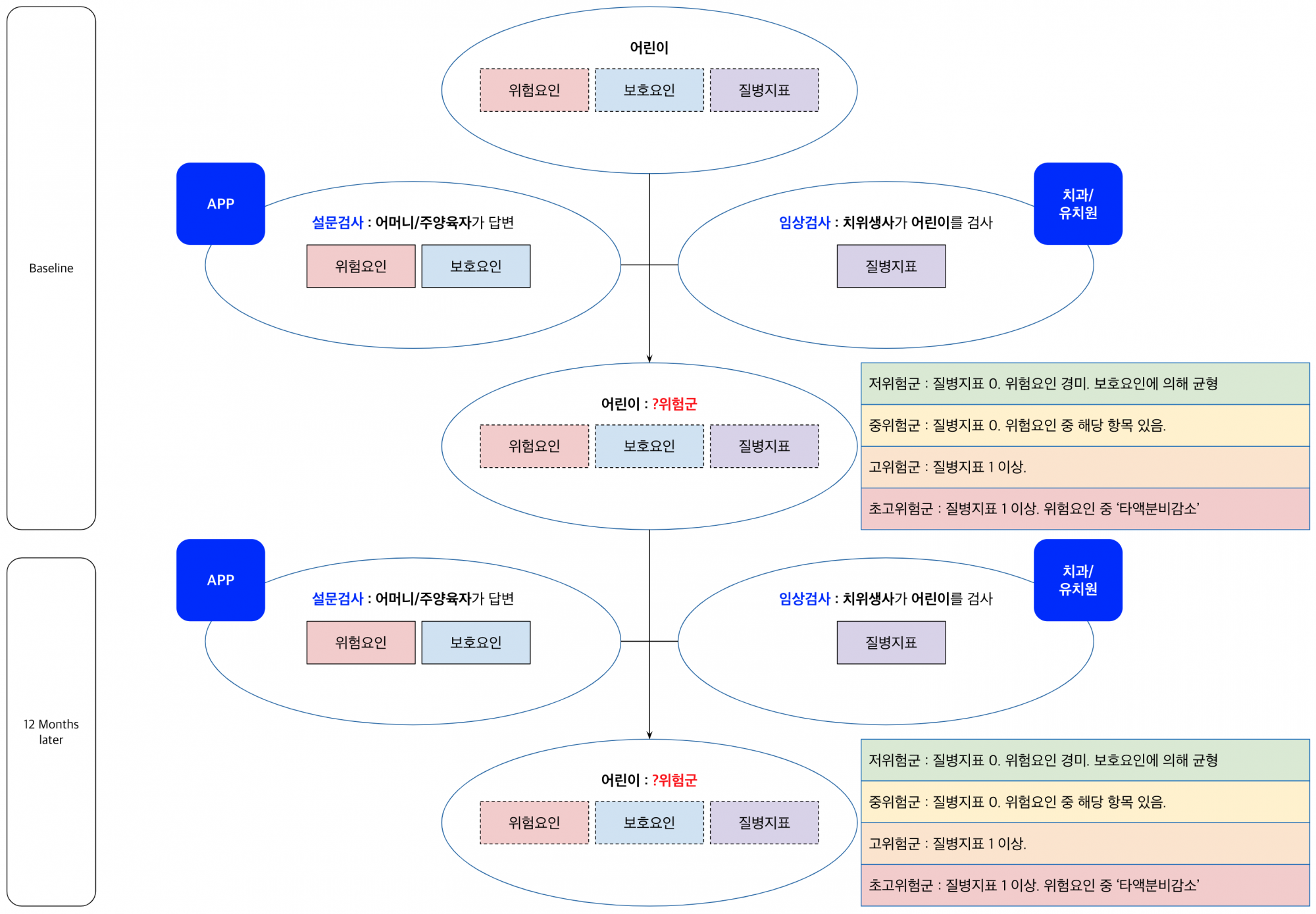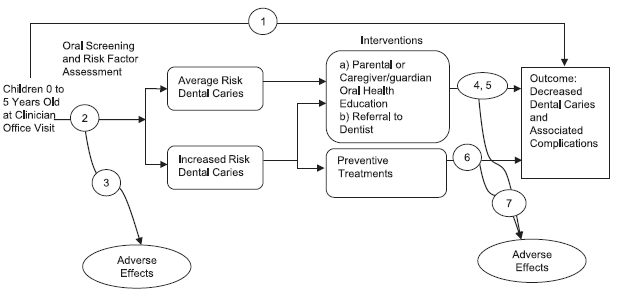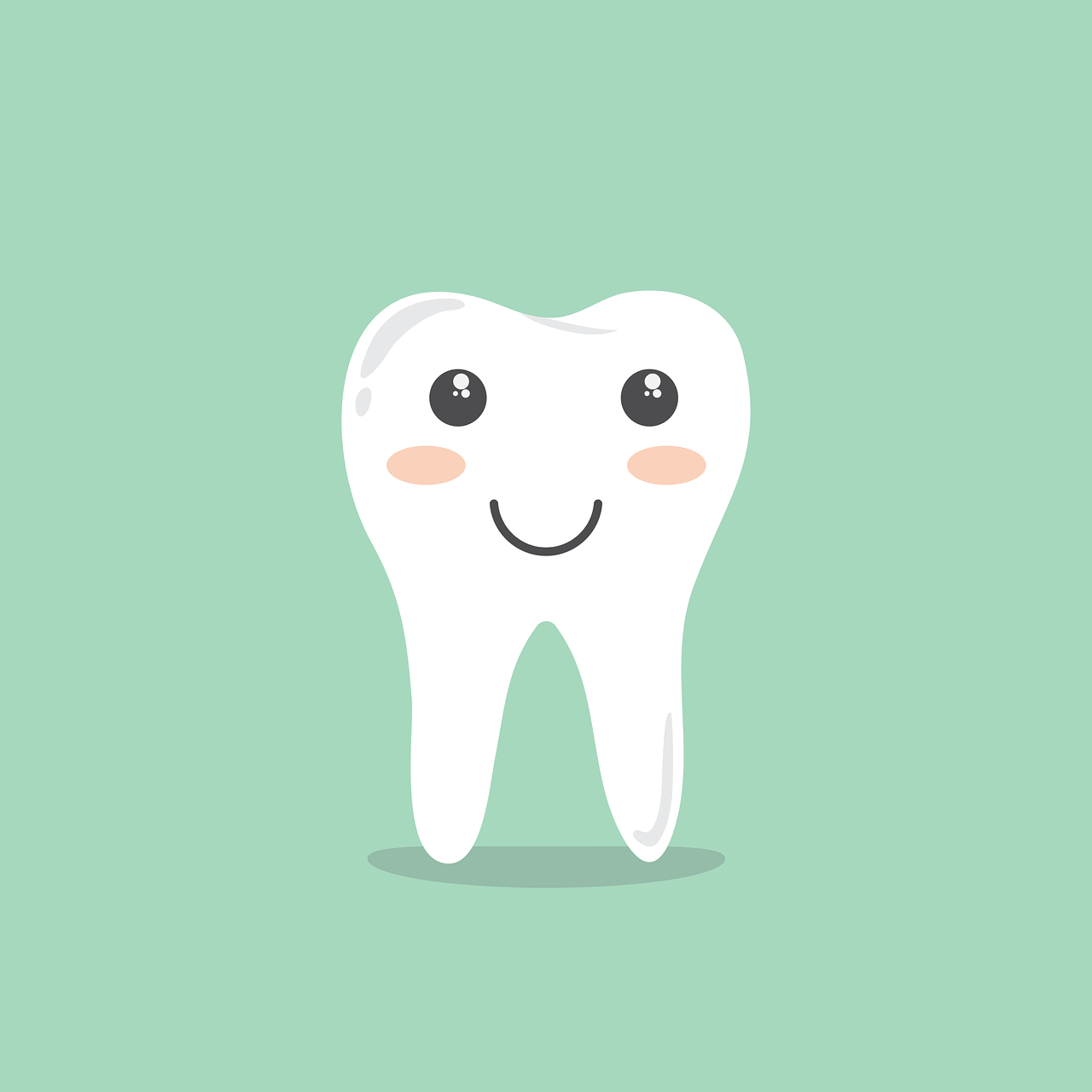102 어린이 충치 위험도 예측
Conclusion
본 연구는 2016년 대한건강 패널의 연간 자료를 활용하여 만성질환자 3,557명의 치과 이용 및 지출과 치과 이용 및 지출에 영향을 미치는 요인을 파악하여 기초 데이터를 제공하고 치과 이용의 불평등 격차를 해소하였다.
1. 만성질환 환자의 치과 이용 빈도는 일반 환자에 비해 높은 편이었다.
65세 이하, 학력수준이 고등학교 졸업 이하인 사람들. 장애인이 없는 대상자와 주관적 건강 상태가 좋은 대상자의 경우 치과 이용 빈도가 상대적으로 낮았다.
2. 만성질환 환자의 치아비용지출은 65세 미만인 대상자와 가구소득이 많은 대상자가 높았다.
위의 조사결과는 만성질환을 효율적으로 관리하여 치과이용률을 조절하는 계획과 치과진료에 대한 보험 미가입 의료비를 보완하는 정책기반의 계획이 필요하다는 것을 시사한다.





CAMBRA kids



Caries Risk Assessment
Different factors included in each standardized Caries Risk Model
| Software programs | American Dental Association models | |||||
|---|---|---|---|---|---|---|
| Factors | NUS-CRA 11 factors |
Cariogram 9 factors |
PreViser 11 factors |
ADA 11 factors |
CAMBRA 14 factors |
CAT 12 factors |
| Socio-demographic | ||||||
| Age | X | X | ||||
| Ethnicity | X | |||||
| Family socioeconomic status | X | X | X | X | ||
| Behavioural | ||||||
| Infant feeding history | X | X | ||||
| Diet | X | X | X | X | X | X |
| Fluoride | X | X | X | X | X | X |
| Dental attendance | X | X | X | X | ||
| Clinical | ||||||
| Oral hygiene | X | X | X | X | X | X |
| Past caries | X | X | X | X | X | X |
| White spot lesions | X | X | X | |||
| Enamel defects | X | |||||
| Dental appliance | X | X | X | X | ||
| Systemic health | X | X | X | X | X | X |
| Medication | X | X | ||||
| Salivary and microbiological | ||||||
| Saliva flow rate | X | X | X | X | X | |
| Saliva buffering capacity | X | |||||
| Mutans streptococci | X | X | X | X | X | |
| Lactobacilli | X | X | X | X | ||
NusCra National University of Singapore Caries Risk Assessment, CAMBRA Caries Management By Risk Assessment, ADA caries risk assessment by American Dental Association, CAT America Academy of Pediatric Dentistry’s Caries Assessment Tool
참고자료
관련 척도 : FS-T수(Functioning Teeth index)는 건전치와 처치치는 같은 ‘기능’을 한다는 가정 하에서 두 종류의 치아 수를 합산한 것
저자
강유민 : H.P: 010-3694-6095, E-mail: yumin6095@daum.net
예측도구 : Cambra Kids
앱 다운로드 : https://apps.apple.com/us/app/id1436936911
구글플레이 검색어 : 캠브라키즈, cambrakids
관련 논문 : 소아 우식관리를 위한 CAMBRA-kids 애플리케이션 개발 및 휴리스틱 평가
데이터 : Table 15 Comparison of factors change between baseline and after 12 months
– 모바일 애플리케이션 평가 검사 도구
– 앱 효용성 및 만족도 평가 설문
용어
질병지표 : 치료를 받으면 질병지표가 올라갑니다.(출처 : 이수영 교수)
참고문헌
Caries Management by Risk Assessment(CAMBRA) 모형에 따른 임상 예방치과 및 치위생진료(남서울대학교 치위생학과, 조영식)
1) 고위험 범주 : 먼저 ‘질병 지표’ 중 해당 항목이 있는지 평가한다. 한 항목 이상 해당할 경우 ‘고위험’으로 평가한다. 고위험 범주는 기준이 명확하다.
특정 병리 요인과 위험 요인이 질병의 진행, 중지, 역전에 영향을 준다. 치면세균막이 많으나, 우식의 증거가 없는 경우도 있다. 우식 와동이 있는 경우, 모두 고위험군에 포함된다. 우식 와동은 우식 발생의 강력한 예측지표로 활용된다.
2) 초고위험 범주 : ‘질병 지표’ 중 한 항목 이상이 해당하고, ‘위험 요인’ 중 ‘타액 분비 감소’ 항목이 해당하면 ‘초고위험’으로 평가한다.
3) 중위험 범주 : 질병 지표 중 해당 항목이 없으나, 위험 요인 중 몇 항목이 해당하면 ‘중위험’으로 평가한다. 따라서 중위험 범주 선정 은 임상가에 따라 다른 결론에 도달할 수 있다.
4) 저위험 : 중위험에 해당하나 ‘보호 요인’에 의해 우식 균형이 유지되는 경우와 위험 요인이 경미하거나 없는 경우 저위험으로 평가한다.
Cambra kids




| Items | Original | 1st translation | Reverse translation |
| Risk
factor |
(a) Mother or primary caregiver has had active dental decay in the past 12 months* | 어머니 또는 보호자가 지난 12개월동안 활동성 치아 우식을 경험했다. | A mother or a guardian of the child has experienced dental caries in the past 12 months. |
| (b) Child continually uses bottle – contains fluids other than water | 아이가 물보다 음료가 함유된 병을 계속적으로 사용한다. | A child continually uses a bottle which contains beverages other than water. | |
| (c) Child sleeps with a bottle, or nurses on demand | 아이는 병을 물고 자거나 젖을 물고 잔다. | A child sleeps while using a feeding bottle or getting breastfed. | |
| (d) Frequent (>3 times/day) between-meal snacks of sugars/cooked starch/sugared beverages | 식사(밥)와 식사 사이에 설탕이 함유된 간식, 탄수화물요리, 설탕이 함유된 음료를 하루 3번 이상 섭취한다. | Eating, such as sugary snacks, carbohydrate foods, or sugary drinks, at least 3 times a day between meals is performed, | |
| (e) Saliva-reducing factors are present, including:
1. medications (e.g., some for asthma [albuterol] or hyperactivity) 2. medical (cancer treatment) or genetic factors |
아래와 같은 타액감소요인이 존재한다.
약 (천식약 (알부테롤) 또는 과다활동(활동항진증약)) 의료적인 요인(암 치료)이나 유전적 요인들 |
Such saliva reduction factors exist under these circumstances:
1. Medicines (anti-asthmatic(albuterol) or hyperactivity (hyperactivity pills) 2. Medical factors (cancer treatment) or genetic factors |
|
| (f) Child has developmental problems/CSHCN (child with special health care needs) | 아이는 발달장애를 가지고 있거나 특수건강관리가 필요하다 | A child either has a developmental disability or requires a special healthcare. | |
| (g) Caregiver has low health literacy, is a WIC participant and/or child participates in Free Lunch Program and/or Early HeadStart | 건강지식이 낮은 보호자는 WIC 참가자이거나 아이는 무료점심급식이나 Early Head Start에 참여한다. | A guardian with a below average knowledges about health is a WIC participant, or a child is in the free lunch program or joins the Early Head Start program. | |
| Protect
factor |
(a) Child lives in a fluoridated community or takes fluoride supplements by slowly dissolving or as chewable tablets (note resident ZIP code) | 아이는 불소화된 지역사회에 거주하거나 천천히 용해되거나 씹을 수 있는 알약형태의 불소첨가제를 섭취한다(주거지 우편번호 기재) | A child lives in a fluorosed community or intakes a fluoride additive pill, which can be dissolved slowly or is chewable. (Write the address and zipcode) |
| (b) Child drinks fluoridated water (e.g., use of tap water) | 아이는 불소가 함유된 물을 마신다.(예를 들면, 수돗물) | A child drinks water, which contains fluoride. (For example, tap water) | |
| (c) Teeth brushed with fluoride toothpaste (pea size) at least 2x daily | 적어도 하루에 2번 불소가 함유된 치약으로 칫솔질을 한다. | Brush one’s teeth with a toothpaste containing fluoride at least 2 times a day.–>pea size 누락됨 | |
| (d) Fluoride varnish in last six months | 지난 6개월 동안 불소 바니쉬를 했다 | In the past 6 months, a fluoride varnish is applied. | |
| (e) Mother/caregiver chews/dissolves xylitol chewing gum/lozenges 2–4x daily | 어머니/보호자는 매일 2-4번의 자일리톨 껌을 씹던지 자일리톨 정제를 먹는다. | A mother/guardian chews xylitol gum or ingests refined xylitol at least 2-4 times a day. | |
| (f)Child has dental home and regular dental care | 아이는 치과진료소에서 정기적인 치아관리를 받는다. | A child gets a regular dental care at a dental clinic. | |
| (g)Mother/caregiver decay-free last three years | 어머니/보호자는 지난 3년간 치아 우식이 없었다. | A mother/guardian has never experienced dental caries in the past 3 years. | |
| Disease
indicator |
(a) Obvious white spots, decalcifications enamel defects or obvious decay present on the child’s teeth* | 아이 치아에 명백한 흰 반점, 법랑질 칼슘결함 또는 치아 우식이 존재한다. | A definite white spot, enamel defects in calcium, or dental caries exists on a child’s teeth. |
| (b) Restorations present (past caries experience for the child)* Yes | 예전 충치로 인한 치료받은 치아가 있다 | There is a dentally treated tooth because of the cavity. | |
| (c) Plaque is obvious on the teeth and/or gums bleed easily | 치아에 명백한 치태가 존재하고 잇몸에서 피가 쉽게 난다 | There is a definite sign of dental plague and the gum bleeds easily. | |
| (d) Visually inadequate saliva flow | 육안 적으로 볼 때, 타액분비가 불충분하다. | There is a deficiency of saliva with the naked eye. | |
| (e) New re-mineralization since last exam(list teeth): | 지난 검진 이후로 새로운 re-mineralization이 존재한다. | Since the last check up, there is a new re-mineralization. |
국내외 치과위생사제도
교육제도
| 구분 | 국 가 | 명 칭 | 등록
인력 |
교육연한 | 석사
과정 |
박사과정 |
| 남•북
아메리카 |
미국 | •치과위생사 (Dental Hygienist): 185,000명
•치과치료사 (Dental Therapist): 99명 |
185,099 | 2~4년 | 있음 | 없음 |
| 캐나다 | •치과위생사 (Dental Hygienist) | 29,549 | 2~4년 | 있음 | 있음2) | |
| 아시아 | 한국 | •치과위생사 (Dental Hygienist) | 85,103 | 3-4년 | 있음 | 있음 |
| 일본 | •치과위생사 (Dental Hygienist) | 123,831 | 3-4년 | 있음 | 있음 | |
| 오세
아니아 |
뉴질랜드 | •치과위생사 (Dental Hygienist) : 343명
•치과치료사 (Dental Therapist) : 433명 •구강건강치료사 (Oral Health Therapist): 582명 |
1,358 | 3-4년 | 있음 | 있음 |
| 오스트레일리아 | •치과위생사 (Dental Hygienist) : 1,442명
•치과치료사 (Dental Therapist): 876명 •구강건강치료사 (Oral Health Therapist): 1,873명 •치과위생사/치과치료사 : 453명 |
4,644 | 2-3년 | 없음 | 없음 | |
| 유럽 | 영국 | •치과위생사 (Dental Hygienist) : 7,346명
•치과치료사 (Dental Therapist) : 3,387명 |
10,773 | 2-4년 | 있음 | 없음 |
| 핀란드 | •치과위생사 (Dental Hygienist) | 3,000 | 4년 | 있음 | 있음 | |
| 스웨덴 | •치과위생사 (Dental Hygienist) | 4,285 | 3-4년 | 없음 | 없음 | |
| 스위스 | •치과위생사 (Dental Hygienist) | 2,141 | 3-4년 | 없음 | 없음 | |
| 네덜란드 | •치과위생사 (Dental Hygienist)
•치과치료사 (Dental Therapist) •치과위생사/치과치료사 : 2,400명 |
4,500 | 3-4년 | 있음1) | 있음 | |
| 덴마크 | •치과위생사 (Dental Hygienist) | 2,345 | 3-4년 | 있음 | 있음 |
출처.
박명숙 외 공저. 치위생학입문. 서울; 대한나래출판사, 2018.
2019년 제21차 세계치과위생사연맹(IFDH) Country report 발표자료
1)윤정원(2019). 치과위생사의 업무 범위에 관한 법 제도 개선 방안. 동의대학교 박사학위논문
2)장영은(2017). 치과위생사의 구강보건 업무 범위 및 권한에 관한 다국적 비교. 연세대학교 석사학위논문
업무권한기준

Direct supervision(직접 감독권) : 치과위생사 업무 수행 시 치과의사가 반드시 진료현장에 있어야 하는 경우,
General supervision(일반 감독권) : 업무수행 시 치과의사가 반드시 진료현장에 있을 필요가 없는 경우
Direct Access : 치과위생사 단독업무 보장받는 경우

